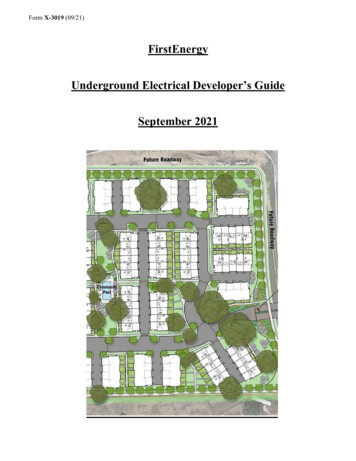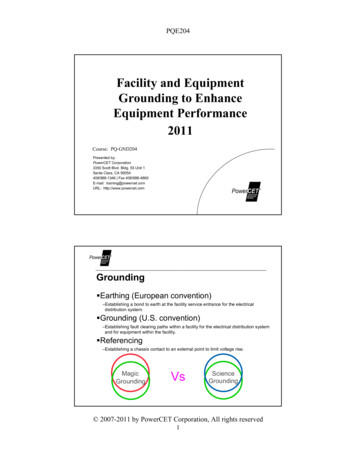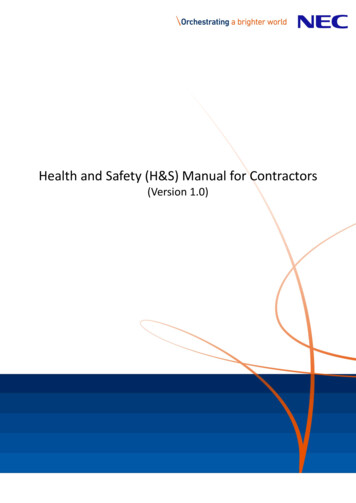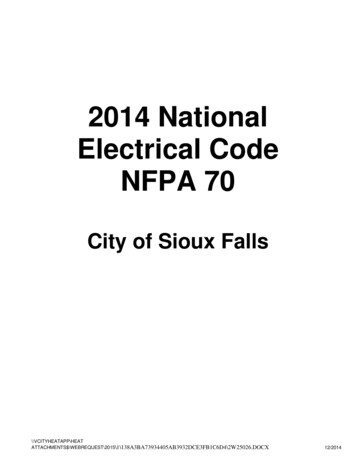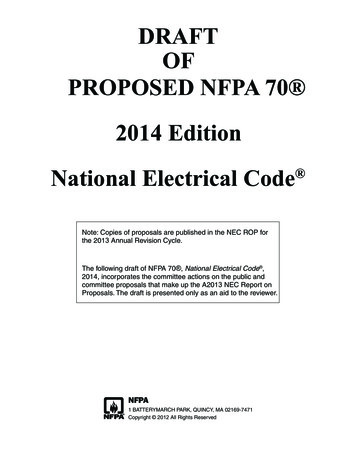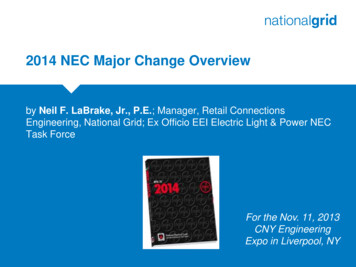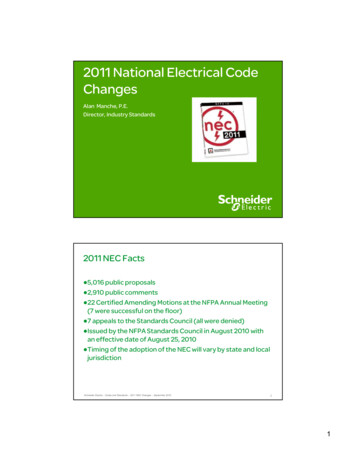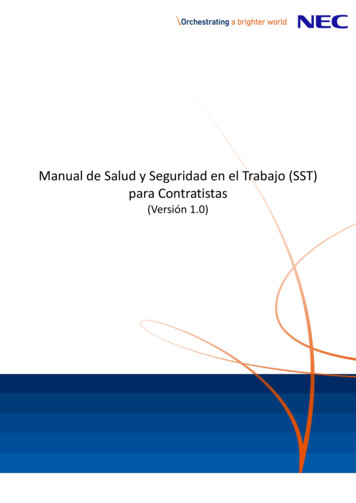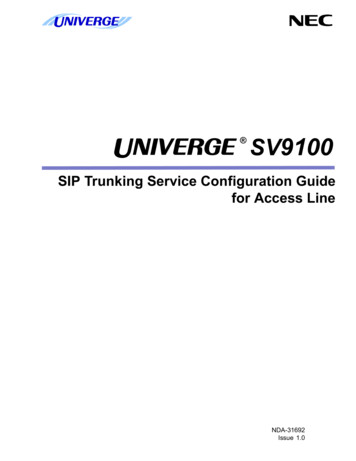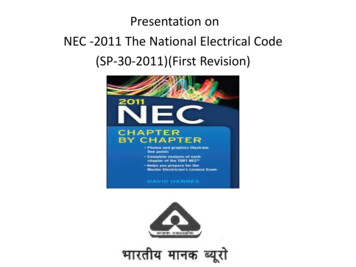
Transcription
Presentation onNEC -2011 The National Electrical Code(SP-30-2011)(First Revision)
To day’s topics NEC Code -2011- The salient features IS 5216 (Part 1): 1982 Recommendations on SafetyProcedures and Practices in Electrical Work: Part 1General IS 5216 (Part 2): 1982 Recommendation on SafetyProcedures and Practices in Electrical Work: Part 2Life Saving Techniques for treatment for electricshock
NEC 2011- The main object of this code This codes of practice provides guidance on economic selection,installation and maintenance of electrical equipment employedin the electrical energy installation including safety aspects. The code is an elaborated version of the IE Rules 1956, IE Act2003 and relevant standards for the best practices and toprovide, unified practices and procedures along withconsideration for safety and economic usage of energy in thedesign, execution, inspection and maintenance of electricalinstallations of various locations. The National Electrical Code is used, nationally andinternationally as the basis for safeguarding persons, buildings,and their contents from hazards arising from the use ofelectricity.
Reference standards for application of this code. During the application of this code the followingstandards are also taken as guide line for eachprocess IE Act 2003 General policy decisions IE Rule 1956 and CEA Regulations 2010 Safetyregulations in Electrical installations EC Act 2001 For Energy conservation and Energysustainability Factory rules 1948 Among other points Safety inelectrical installations IS 15652, IS 3043 , IS 3034 etc.,
Types of Accidents Hazard identification and risk assessment, Preventionand Control methods have been discussed in IE Rulesand CEA Regulations and other statutory standards. Most of the Accidents identified are due to 1. Fire 2. Hazardous chemicals, gases and Oils 3. Direct contact with Electricity 4. Fall from heights, confined space 5. Static Energy Generation
Hazards that Associate with Electricity Falls from ladder, thrown back fall to the ground on a sharp edgedue to Electric shock. Accidents due to Electricity Induction. Thermal burns – due to fire accidents because of ElectricalAccidents. Wires or cables – uninsulated portion of wires and cablesdamaged cables or wires. Associated with unorganized sector Heavy explosions in Substations, Transformers, Circuit breakers,CTS and PTs etc. Electrical hazards due to lightning,/ conductor snapping/ Pole/Towers breaking and damages due to heavy gales and thunderstorms. Improper maintenance of Transformers and live parts contactwith green plants etc., Oil leakages and spillages in the Transformer yard. Storage ofHazardous oils with in the vicinity of live transformers etc., Conductor snapping on HT/EHT lines.
Common sources identified on a power systems underIE Rules 1956 are1. Lightning form high raised structures2. Switching surges3. Contact LT lines with a high voltage lines and or maybe other system4. Line to ground fault5. Failure of lightning arrestors
Scope of NEC Code -2011NEC -2011 The National Electrical Code Coversa) Good practices of safety and for selection of various electricalequipment forming part of power systems;b) Recommendations concerning safety and related matter inelectrical installations of buildings or industrial, structures,promoting recommendationsc) General safety procedures and practices in electrical work;d) Additional precautions to be taken for use of electricalequipment under special environmental conditions like explosiveand other chemicals Ex: Mining, Pharma and Chemical Industries.
NEC-2011 APPLIES TO: Standby generating plantsBuilding substationsDomestic dwellingsOffice buildings either Govt. andPrivate.Shopping and commercialcomplexesEducational and otherInstitutionsRecreation and other publicpremisesMedical establishments Hotels Sports buildings Industrial premises Temporary and permanentoutdoor installations Agricultural premises Installations in hazardousareas Solar Photovoltaic installations Transmission and Distributionsystems
National Electric Code Applies in general It covers the requirements relating to standby oremergency generating stations and captive substationsintended for serving an individual occupancy and intendedto serve a building or a group of buildings normally housedin and around it. Ex: Gated communities It gives guidelines on layout and building constructionaspects, selection of equipment, transformer installations,switching stations and station auxiliaries. Harmonized with corresponding IEC standards, IndianSpecification Standards Code is intended to be advisory, not mandatory
NEC CODE application at Hazardous areas Many liquids, gases, vapours and chemicals an industrygenerated, processed, handled and stored. The areascomes under Zone 0( More hazardous),Zone1 and Zone 2 With regard to electrical installations, ignition sourcesinclude arcs, sparks or hot surfaces produced either innormal operation or under specified fault conditions. NEC provides guidelines for electrical installations andequipment in locations where a hazardous atmosphereis likely to be present with a view to maximizingelectrical safety.
NEC contains 8 parts with 30 sections. Part 1 General and Common Aspects in Transmissionsystems. Part 2 Electrical installations in stand by generatingstations and captive substations Part 3 Electrical installations in non Electricalinstallations in non-industrial Part 4 Electrical installations in industrial buildings Part 5 Outdoor installations Part 6 Electrical installations in agricultural premises Part 7 Electrical installations in Hazardous area Part 8 Solar Photovoltaic (PV) power supply systems
Part 1 General and Common Aspects Section 1 Scope of the National Electrical Code Section 2 Definitions Section 3 Graphical Symbols for Diagrams, Signs Section 4 Guide for preparation of diagrams, tables,and marking Section 5 units and systems of measurement Section 6 Standard Values Section 7 Fundamental principles Section 8 General Characteristics of buildings Section 9 Wiring Installations
Section 10 Short Circuit Calculations Section 11 Electrical aspects of building services Section 12 Selection of equipment Section 13 Erection and pre commissioning testing ofinstallations. Section 14 Earthing Section 15 Lightning protection Section 16 Protection against voltage surges Section 17 Guidelines for power factor improvement Section 18 Energy Efficiency aspects Section 19 Safety in electrical work Section 20 Tables
Part I Section 1 Cl 3.2 This code applies to Electrical installationsfor selection of various equipment w.r.t to safety in the followinginstallations a) Standby/emergency generating plants and buildingsubstations; b) Domestic dwellings; Office buildings, shopping and commercialestablishments includes identification of escape routes. d) Recreation and other public premises; e) Medical establishments; f) Hotels & Restaurants;g) Sports buildings;h) Industrial premises; j) Temporary and permanent outdoor installations; k) Agricultural premises; m) Installations of specific equipment in hazardous areas; L) Solar photovoltaic installations.
Under Part 1 Section 7 Fundamental Principles 3.0.1 The installations should be in conformity withI E Rules 3.0.2 Materials : All materials, fittings, equipmentand their accessories, appliances, etc, used in anelectrical installation shall conform to safetystandards. 3.2 Distance from Electric Lines No building shall beallowed unless the following minimum clearancesare provided from the overhead electric supplylines:
Clearances of the lines from the buildings (Refer IE Rules also)VoltagesVertical clearanceHorizontalClarenceLow and Medium2.5 Mtrs1.2 mtrsHigh Voltage upto11 KV3.7 Mtrs1.2 mtrs11 KV -33 KV3.7 Mtrs2.0 mtrsEHT 33 KV3.7 Mtrs2.0 mtrsFor extra high voltage lines apart from the minimumclearances indicated, a vertical and horizontal clearance of0.30 m for every additional kV or part thereof shall be provided.
Under Part 1 Section 7 Fundamental Principle 3.3 Lighting and Ventilation: general requirements discussed inPart 1/Section 14. 3.6 Location and Space for Electrical control Equipment . Need for and location and requirements of building substation. b) Load centre , c) Layout, d) Room/spaces required for electrical utility, e) Location and requirements of switch rooms, f) Levels of illumination, and g) Ventilation.
Cl:4 Part-1 Section 7DESIGN OF ELECTRICAL INSTALLATION Cl 4.0.2 The following factors shall therefore be kept in viewwhile designing: a) Characteristics of the available supply or supplies, b) Nature of demand, c) Emergency supply or supplies, d) Environmental conditions, e) Cross-section of conductors, f) Type of wiring and methods of installations, g) Protective equipment, h) Emergency control, j) Disconnecting devices on emergencies,
Cl 4 Section 7 Part-1 4.1 Protection for Safety: Ex: a) Shock currents; and b) Excessive temperatures likely to cause burns, fires andother injurious effects. 4.2.5 Cross-section of Conductors The cross-section of conductors shall be determinedaccording to: maximum temperature, voltage drop,electromechanical stresses likely to occur due to short-circuits 4.2.8 Emergency Control 4.2.11 Accessibility to Electrical switchgear for ease ofoperation during emergency
Section 8 ASSESSMENT OF GENERAL CHARACTERISTICS OFBUILDINGS( We are not much concerned about this section)SECTION 9 WIRING INSTALLATIONS (Part-1)This Section 9 of the Code covers the essential designand constructional requirements for electrical wiringInstallations4.1 Principles of Good and adequate Lighting4.1.1 Cable for AC Circuits4.1.2 Electromechanical Stresses IN PVC wiring, cables4.1.3 Guidelines on principles of good lighting design can be hadfrom IS 3646 (Part 1). Reference should be made to NationalLighting Code, or National Electric code
Cl 5 ,Section 9 Part1MAINS INTAKE AND DISTRIBUTION OF ELECTRICAL ENERGY INCONSUMERS’ PREMISES 5.1 Distribution Board System 5.2 Distribution Boards to be designed and selected in such away to provide plenty of wiring space, adequate size toaccommodate the cables including surge protective device andearth leakage protective devices. 5.2.6 Circuit Charts, single line diagrams and Labelling on theequipment 5.2.4 Location of Distribution Boards 5.4 Correct Sizes of Cables, by total load is expected to beconnected with 10-15% factor of safety
Section 9 of Part-I5.6 MV/LV Bus bar Chambers (400/230V)5.7 Earthed Neutrals To comply with IE Rules, 1956 and CEARegulations5.8.14 Identification of Cables and Conductors IS 11353 givesguidance on uniform system of marking and identification ofcables and conductors.5.14.2 Emergency Lighting is very critical for at hospitals,theatres, hotels, factories, offices, shops, cinemas and certainspecified places of entertainment and practically all types ofpremises excluding houses.5.14.1 Lighting Adequate lighting is to be provided5.14.3 Fire Alarms and Detection
SECTION 10SHORT-CIRCUIT CALCULATIONS IS No. 13234 : 1992 Guide for short circuit calculation inthree phase ac systems 13235 : 1991/ Calculation of the effects of short IEC 865(1986) circuit currents This Part 1/Section 10 covers guidelines, short circuitcalculations and voltage drop calculations for cables andflexible cords and other equipment. Ex: Transformers,Induction motors etc.,
Short circuit calculations equipment Section 10 Short circuit calculations of the transformers, Inductionmotors : Fault calculations are one of the most commontypes of calculation carried out during the design andanalysis of electrical systems. These calculations determine the maximum currentflowing through circuit elements during abnormalconditions – short circuits and earth faults. This will also help us to calculate the size of the earthconductor as per IS 3043( Details can be seen inspecification.),Insulation values of windings etc.
Short circuit calculation on 100KVA Transformer for Example Transformer rating in kVA., 100 KVAImpedance (Z%): Z 5% impedance.The transformer short circuit current is calculated as follows:I fault actual T/F Cap / 3 V Z%where I fault 100 KVA/ 1.732X 415 VX 5% 2778 AmpsFault current on Secondary side of T/F at Full loadcondition 2.778 KA As per IS 3043, Cross Section Area of Earthing Conductor (A) (If x t) / K Where: t Fault current Time (Second). K Material Constant. K 205(copper) A 2778 A/205 13.55 Sq MM x 1.5 Factor of safety 20Sqmm 6x 4mm Flat is adequate.
SECTION 11 ELECT ASPECTS OF BUILDING SERVICES The buildings include commercial, administrative, high raisedbuildings 4.1.2 Good lighting design shall take into account thefollowing: a) Planning the brightness pattern, visual performance,safety and amenity and surroundings; b) colour rendering index c) Controlling glare, stroboscopic effect and flicker; d) Lighting for movement; e) Provision for emergency lighting in walk ways andcommon corridors; g) Maintenance factors in lighting installation;
Section 11 5.1 Methods of Ventilation 6.0 Air conditioning and heating services 7 Electrical aspects of Lifts and escalators Number of lifts, size, capacity and position; b) Number of floors served by the lift; c) Height between floor levels; d) Provisions for machine room and proper access to it; e) Provisions for ventilation and emergency lighting; Communicationsystems in the lift. 9.0 ELECTRICAL ASPECTS OF FIRE ALARM AND FIGHTING SYSTEMS 9.1 Fire and smoke Detectors, 9.2 Wiring for Fire Alarm Systems 9.3 Fire Fighting Equipment and escape routes.
Part-1 SECTION 12 : SELECTION OF EQUIPMENT Section 12 of the Code covers general criteria for selection ofequipment. NOTE — This Part 1/Section 12 shall be read in conjunctionwith the Indian Standard/Codes on individual equipment 2.4 Prevention of Harmful Effects All electrical equipment shall be selected so that it will notcause harmful effects on, during normal service includingswitching operations. the other factors which may have aninfluence on selection of equipment include;a) Power factor,b) Inrush current,c) Asymmetrical load, andd) Harmonics in the supply system.e) Maximum fault current that it can with stand
Part-1 Section 13 Cl 4 / Section 13 INSPECTION AND TESTING 4.1.1 Inspection and testing shall be carried out to put in servicewith the I E Rules, 1956 for the completed installations oraddition and alteration takes place or any installation is not in usefor more than 6 months, the pre commissioning test is to beconducted before the restart. 4.1.2 After putting the installation into service periodicinspection and testing shall be carried out. At the completion of wiring, a general inspection shall be carriedout by competent personnel to verify that the provisions of thisCode and that of I E Rules, 1956 have been complied with Ex: Motors, Transformers, cables including IR Values, breakers etc.
Cl 4.3.7 / Sec 13 Part-1 Earthing For checking the efficiency of earthing the following tests arerecommended (see IS 3043): a) The earth resistance of each electrode is measured. b) The earth resistance of earthing grid is measured. c) All electrodes are connected to the grid and the earthresistance of the entire earthing system is measured. These tests shall preferably be done during the summermonths
SECTION 14 EARTHING ( This subject will be discussed inanother session in detail. This Part 1/Section 14 of the Code covers generalrequirements associated with earthing in electricalinstallations. Specific requirements for earthing in individual installationsare covered in respective Parts of the Code. NOTES 1 This Section shall be read in conjunction with theprovisions of IS 3043-1987.
What does the Earthing means “Earthing” means the provision of a safe path of electricalcurrent to ground, in order to protect structures, plant andequipment ,and safety of human beings from the effects of strayelectrical current, and electrostatics discharge; Also by providing such an earth surface of uniform potentialunder and surrounding the station, there can exist no differenceof potential in a short distance big enough to shock or injure anattendant when short-circuits or other abnormal occurrencestake place.
.Processes and Equipment to be earthed Earthing of equipment atgenerating stations Earthing of transmission lines,distribution lines etc., highmast lighting, communicationtowers Earthing of Substations andEquipment Earthing of industrialconsumers’ main panels Data processing installations.distribution panels,transformers, motors and Earth fault protection inother equipment which areconsumer’s premiseselectrically connected. Power stations, substationsand overhead lines; Industrial premises; Standby and other privategenerating plant; Medical establishments; Static and lightningprotection grounding;
Types of Earthing System Earthing : The neutral point in all electrical installationsof the system is to be earthed.Neutrals of Transformers, induction motors, the circuits indistribution panels, instrument transformers both circuitry of HTand LT energy meters for system stability ,cables neutral systemsearthing. Equipment Earthing . Body of electrical equipment should beearthed.Equipment such as motors transformers, panels, energy meters,computers, high frequency equipment like x-ray units, all domesticappliances , industrial appliances etc., should be properly earthed.
System earthing IS 3043 -1987
SECTION 15/Part I LIGHTNING PROTECTION IS 2309 : 1989 ‘Code of practicefor the protection of buildingsand allied structures againstlightning (second revision)’ forthis Section. IS 15086 : Part5/Surge arrestorsZONE OF PROTECTIONRef Cl8.2 of IS 2309The zone of protection of alightning conductor denotes thespace within which a lightningconductor provides protectionagainst a direct lightning stroke.
Shapes and Minimum Sizes of Conductorsfor Use Above Ground for the purpose of Earthing Material and Shape Minimum Size i) Round copper wire or copper-clad steel wire6 mm diameter ii) Stranded copper wire 50 mm2 (7/3.00 mm)diameter) iii) Copper strip20 mm 3 mm iv) Round GI wire8 mm diameter v) GI strip20 mm 3 mm vi) Round Al wire9 mm diameter vii) Aluminium strip25 mm 3.15 mm
Section 15 Lightning arrestors 9.3 Joints and Bonds in thelightning conductor 9.3.1 Joints are not allowed inbetween. 9.4 Testing Points Each down conductor shall beprovided with a testing point in aposition convenient for testingnormally at height of 1.5 mt fromground level. 9.8 Earth Resistance, soil resistance 9.6 Earth Electrodes 12.1 Inspection All lightning protective systemsshall be examined by a competentengineer A routine inspection shall be madeat least once a year for healthinessof Lightning arrestors.
SECTION 16 PROTECTION AGAINST VOLTAGE SURGESVoltage surges is a sudden change in the operating conditions inan electrical network causes transient phenomena to occur.Transients may be generated may be by lightning and even normalutility switching operations.Inside the home or business, transients are generated by motorsstarting and stopping, fluorescent lighting, copiers, vendingmachines, welding operations, and many other sourcesSection has been derived from IEC 61643-12-2008 ‘Low-voltagesurge protective devices — Part 12:Surge protective devices connected to low-voltage powerdistribution systems — Selection and application principles’.Lightning is a high frequency electrical phenomenon whichproduces voltage surges on all conductive elements, and especiallyon electrical loads and wires.
4.1 Voltage Surges Section 16-Part 1 A voltage surge disturbs equipment and causeselectromagnetic radiation in the electrical circuits which islikely to destroy the equipment. There are four types of voltage surges which may disturbelectrical installations and loads: a) Atmospheric voltage surges, b) Operating voltage surges, c) Transient overvoltage at industrial frequency, d) Voltage surges caused by electrostatic discharge E) Sudden load throw in the system.
Cl 4.3/Section 16 Basic Functions of SurgeProtection Devices (SPDs) During the occurrence ofsurges: the SPD responds tosurges and diverting surgecurrent through it, to limitthe voltage to its protectivelevel. After the occurrence ofsurges: the SPD recovers toa high-impedance state afterthe surges and extinguishesany possible power followcurrent.
4.1.1 Atmospheric VoltageSurges Atmospheric voltagesurges, that is, lightning,comes from the dischargeof electrical chargesaccumulated in theclouds. 4.1.2 Operating VoltageSurges The opening ofprotection devices (fuse,circuit breaker), and theopening or closing ofcontrol devices (relays,contactors, etc).Location at which the surge protectoris installed
SECTION 17 GUIDELINES FOR POWER-FACTOR IMPROVEMENT Assistance has been derived from IS 7752 (Part 1) : 1975 ‘Guidefor the improvement of power factor in consumer installations:Part 1 Low and medium supply voltages’. POWER FACTOR 4.1 The majority of ac electrical machines and equipment drawfrom the supply an apparent power (kVA) which exceeds therequired useful power (kW). This is due to the reactive power (kVAR) necessary for alternatingmagnetic field. The ratio of useful power (kW) to apparent power(kVA) is termed the power factor of the load. The reactive poweris indispensable and constitutes an additional demand on thesystem.
Sec 17 /Part-1 Cl 4.3 Principle Causes of LowerPower Factor 4.3 Principle Causes of Lower Power Factor 4.3.1 The following electrical equipment and apparatus have alower factor: a) Induction motors of all types particularly when they are underloaded, b) Power transformers and voltage regulators, c) Arc welders,d) Induction furnaces and heating coils,e) Choke coils and magnetic systems, andf) Fluorescent and discharge lamps, neon signs, etc.
4.3.2 The principal cause of a low power factor is due to thereactive power flowing in the circuit. The reactive powerdepends on the inductance and capacitance of the apparatusnormally at no load conditions of inductive equipment. 4.4 Effect of Power Factor to Consumer 4.4.1 The disadvantages of low power factor are as follows: a) Overloading of cables and transformer, b) Decreased line voltage at point of application, c) Inefficient operation of plant, and d) Penal power rates by increased power demand.
Section 17 Part 1 Power Factor4.4.2 The advantages of high power factor are asfollows: a) Reduction in the current; b) Reduction in power cost; c) Reduced losses in the transformers and cables, d) Lower loading of transformers, switchgears, cables, e) Reduction in Maximum demand. f) Improvement in voltage conditions and apparatusperformance; and Ex : Agriculture motors. g) Reduction in voltage dips caused by welding andsimilar equipment.
5.3 Capacitors for power factor improvement may bearranged as described in IS 7752 (Part 1).The successful operation of power factor improvementdepends very largely on the positioning of the capacitor onthe system. Ideal conditions are achieved when the highestpower factor is maintained under all load conditions.The location of capacitors normally at load points or at thegeneration point of RKVA.
SECTION 18 ENERGY EFFICIENCY ASPECTS Energy conservation aims at eliminating the waste of energy andminimization of losses. The Energy Conservation Act, 2001, hasbeen constituted by GOI to identify the Energy losses inequipment and recommend the ways to plug the losses and toincrease the system efficiency. This Section provides guidance to the consumers of electricalenergy, with regard to the selection of equipment from energyconservation point of view and on energy audits.
Why Energy audit is required It is due to increase in Power tariffs every year and Electricitybills. Increased demand in power sector as well as the consumer. Increased wastage in power due to innocence and ignorance. Increase in pollution and improper control methods forpollution levels Reduction in fossil fuels across the world and non availability forfuture generation 5.1 ‘Energy Audit’ means the verification, monitoring andanalysis of the use of energy including submission of a technicalreport containing recommendations for improving energyefficiency with cost benefit analysis and an action plan toreduce energy consumption.
Energy efficiency can be increased in the following equipment Induction motorsPower and Distribution TransformerCablesSub station equipmentLightingBoilersAir compressorsInduction FurnacesInternal and external Lighting .Pumps and pump motorsDomestic and agricultural motos
Section 18 –Part 1 5 ENERGY AUDIT- Energy Managers-Energy Auditors-Process ofenergy audit- Calculations of pay back period-report preparation–Discussions with top management –Implementation ofrecommendation made by Energy auditor. 5.4 Energy Conservation Building Code formulated by theBureau of Energy Efficiency and prescribed by the CentralGovernment shall be implemented for new buildings havingconnected load of 500 kW and above or contract demand of 600kVA and above, once the same or modified version has beennotified by the respective State Governments. List of energyintensive industries and other establishments specified asdesignated consumers is given in the Energy Conservation Act,2001
SECTION 19 SAFETY IN ELECTRICAL WORK This Part 1/Section 19 of the Code covers guidelines onsafety procedures and practices in electrical work IS 2551 : 1982 Specification for danger notice boards. IS 5216 (Part 1) : Recommendations on safety 1982procedures and practices in electrical work: Part 1 General IS 5216 (Part 2) : Recommendations on safety 1982procedures and practices in electrical work: Part 2 Life saving techniques 8923 : 1978 Warning symbolfor dangerous voltages SP 31 : 1986 Method of Treatment of Electric shock IE Rules 1956 CEA Safety regulations 2010 Electrical safety clauses in Factory rules of concerned states.
SECTION 19 SAFETY IN ELECTRICAL WORK 3 PERMIT-TO-WORK SYSTEM- Process and procedures –importance of Work permit system – Impart training how tomaintain the work permit systems for all process heads. Standard operating procedures-preparation andcommunication-Training for the relevant personnel Covers safety procedures and practices in electrical work.Standard operating procedures, JSA,HIRA, Correction andcorrective actions-Proactive methods Competency of personnel-Identification of competentpersonnel. Documentation and safety manuals.
5 SAFETY PRACTICES: Top management commitment,frequent training and awareness programmes for allpersonnel including contract employees and maintainrecords to that effect. 6 SAFETY POSTERS 6.1 The owner of every medium, high and extra highvoltage installation is required to fix permanently, in aconspicuous position a danger notice in Hindi orEnglish and the local language of the district on everymotor, generator, transformer, all supports or high andextra high voltage etc. The danger notice plate shallconform to IS 2551 7 ACCIDENTS AND TREATMENT FOR ELECTRIC SHOCK See SP 31and IS 5216 (Part 2).
Main features of Part-I is completed PART 2 of this codeELECTRICAL INSTALLATIONS IN STAND-BY GENERATINGSTATIONS AND CAPTIVE SUBSTATIONS Part 3 of this code.PART 3 ELECTRICAL INSTALLATIONS IN NONINDUSTRIAL BUILDINGS PART 4 ELECTRICAL INSTALLATIONS ININDUSTRIAL BUILDINGSPART 5 OUTDOOR INSTALLATIONS Page 303
End of the Session .Any Questions please ?
NEC -2011 The National Electrical Code Covers a) Good practices of safety and for selection of various electrical equipment forming part of power systems; b) Recommendations concerning safety and related matter in electri
